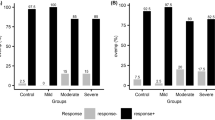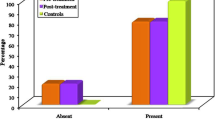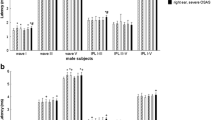Abstract
Obstructive sleep apnea syndrome (OSAS) provokes oxidative stress and ischemia, which affects the central nervous system. The degeneration of neurons in the brainstem due to periodic hypoxia can be evaluated by vestibular and audiologic tests. The objective of this study is to determine brainstem damage in severe OSAS patients with the help of vestibular evoked myogenic potential (VEMP) responses. Prospective, randomize, double-blind. Research—training hospital. We compared cervical vestibular evoked myogenic potential (cVEMP) responses between severe OSAS patients and a control group. 54 patients were included and divided into the OSAS group, with severe OSAS (apnea-hypopnea index, AHI >70), and a control group with snoring without OSAS (AHI <5). Both groups underwent cVEMP. Bilateral recordings with simultaneous binaural logon stimulations were used during VEMP recordings. The existing p1n1 and n2p2 responses, p1, n1, n2, and p2 latencies and amplitudes, and p1n1 and n2p2 intervals were measured. Statistically significant differences were revealed between patients and controls for the response rate of the p1n1, n2p2 and p1n1, n2p2 amplitudes. There were no significant differences between the two groups with respect to the latencies of p1, n1, n2 and p2, or the p1n1 and n2p2 intervals. The VEMP response rate was lower in severe OSAS patients, and all amplitudes were shorter than in healthy subjects. VEMP recordings in severe OSAS subjects demonstrates abnormalities in brainstem pathways. It appears that brainstem damage in severe OSAS can be detected by cVEMP recordings.


Similar content being viewed by others
References
Peppard PE, Young T, Barnet JH et al (2013) Increased prevalence of sleep-disordered breathing in adults. Am Journal Epidemiol. 177(9):1006–1014
Budhiraja R, Parthasarathy S, Quan SF (2007) Endothelial dysfunction in obstructive sleep apnea. J Clin Sleep Med 3(4):409–415
Casale M, Vesperini E, Potena M et al (2012) Is obstructive sleep apnea syndrome a risk factor for auditory pathway? Sleep Breath 16:413–417
Zhang JH, Fung SJ, Sampogna S, Chase MH (2010) Apnea produces neuronal degeneration in the pons and medulla of guinea pigs. Neurobiol Dis 40(1):251–264
O’Donoghue FJ, Wellard RM, Rochford PD et al (2012) Magnetic resonance spectroscopy and neurocognitive dysfunction in obstructive sleep apnea before and after CPAP treatment. Sleep 35(1):41–48
Ivanković A, Mađarić VN, Starčević K et al (2013) Auditory evoked potentials and vestibular evoked myogenic potentials in evaluation of brainstem lesions in multiple sclerosis. J Neurol Sci 328(1):24–27
Bayir O, Comoglu SS, Ozdek A et al (2012) Vestibular evoked myogenic potential responses in Behçet’s disease. Int Adv Otol 8(1):113–117
Eleftheriadoua A, Deftereos SN, Zarikasc V et al (2009) The diagnostic value of earlier and later components of vestibular evoked myogenic potentials (VEMP) in multiple sclerosis. J Vestib Res 19(1):59–66
Güven H, Bayır O, Aytaç E, Ozdek A, Comoğlu SS, Korkmaz H (2014) Vestibular-evoked myogenic potentials, clinical evaluation, and imaging findings in multiple sclerosis. Neurol Sci 35(2):221–226
Murofushi T, Shimizu K, Takegoshi H, Cheng PW (2001) Diagnostic value of prolonged latencies in the vestibular evoked myogenic potential. Arch Otolaryngol Head Neck Surg 127(9):1069–1072
Heide G, Luft B, Frankea J, Schmidt P, Wittt OW, Axer H (2010) Brainstem representation of vestibular evoked myogenic potentials. Clin Neurophysiol 121(7):1102–1108
Colebatch JG, Halmagyi GM, Skuse NF (1994) Myogenic potentials generated by a click evoked vestibulocollic reflex. J Neurol Neurosurg Psychiatr 57:190–197
Chen CH, Young YH (2003) Vestibular evoked myogenic potentials in brainstem stroke. Laryngoscope 113:990–993
Itoh A, Kim YS, Yoshioka K, Kanaya M et al (2001) Clinical study of vestibular-evoked myogenic potentials and auditory brainstem responses in patients with brainstem lesions. Acta Otolaryngol 121(Suppl 545):116–119
Sartucci F, Logi F (2002) Vestibular-evoked myogenic potentials : a method to assess vestibulo-spinal conduction in multiple sclerosis patients. Brain Res Bull 59:59–63
Suzuki M, Yamada C, Inoue R et al (2008) Analysis of vestibular testing in patients with vestibular schwannoma based on the nerve of origin, the localization, and the size of the tumor. Otol Neurotol 29:1027–1031
Kuei-You L, Ying-Shuo H, Yi-Ho Y (2010) Brainstem lesion in benign paroxysmal vertigo children: evaluated by a combined ocular and cervical vestibular-evoked myogenic potential test. Int J Pediatr Otorhinolaryngol 74(5):523–527
Yan B, Soukhova-O’Hare GK, Li L, Lin Y et al (2008) Attenuation of heart rate control and neural degeneration in nucleus ambiguus following chronic intermittent hypoxia in young adult Fischer 344 rats. Neuroscience 153:709–720
Gallina F, Dispenza G, Kulamarva F, Riggio R (2010) Obstructive sleep apnea syndrome (OSAS): effects on the vestibular system. Acta Otorhinolaryngol Ital 30:281–284
Conflict of interest
The authors declare that there is no conflict of interests regarding the publication of this article.
Author information
Authors and Affiliations
Corresponding author
Additional information
This article was presented at the 29th Politzer Society Meeting on November 2013.
Rights and permissions
About this article
Cite this article
Mutlu, M., Bayır, Ö., Yüceege, M.B. et al. Vestibular evoked myogenic potential responses in obstructive sleep apnea syndrome. Eur Arch Otorhinolaryngol 272, 3137–3141 (2015). https://doi.org/10.1007/s00405-014-3294-x
Received:
Accepted:
Published:
Issue Date:
DOI: https://doi.org/10.1007/s00405-014-3294-x




